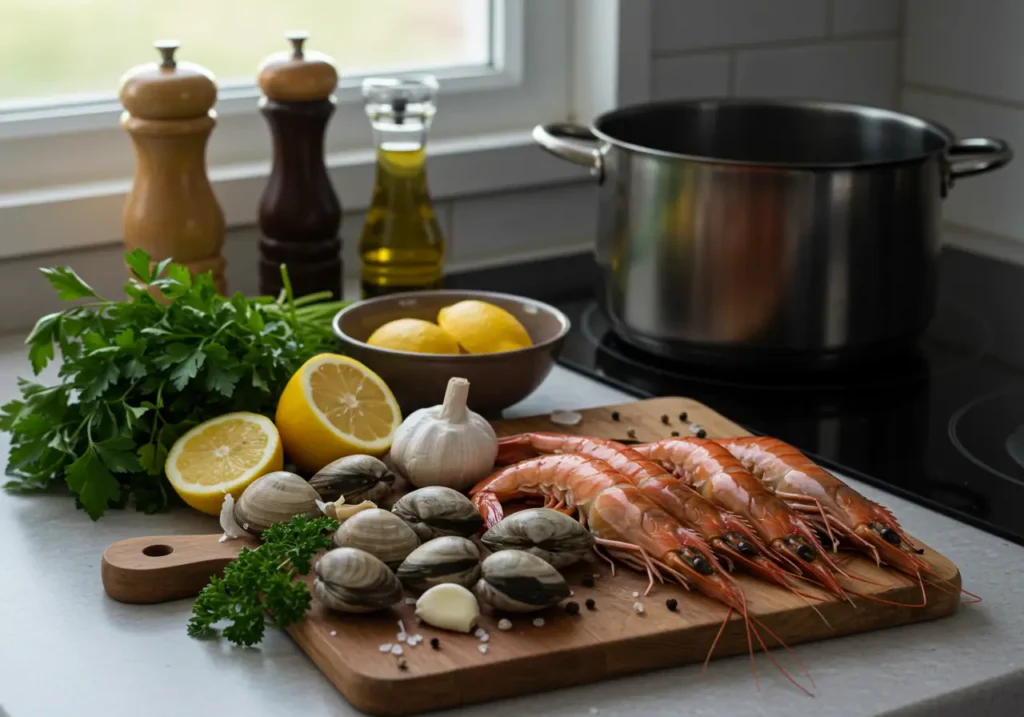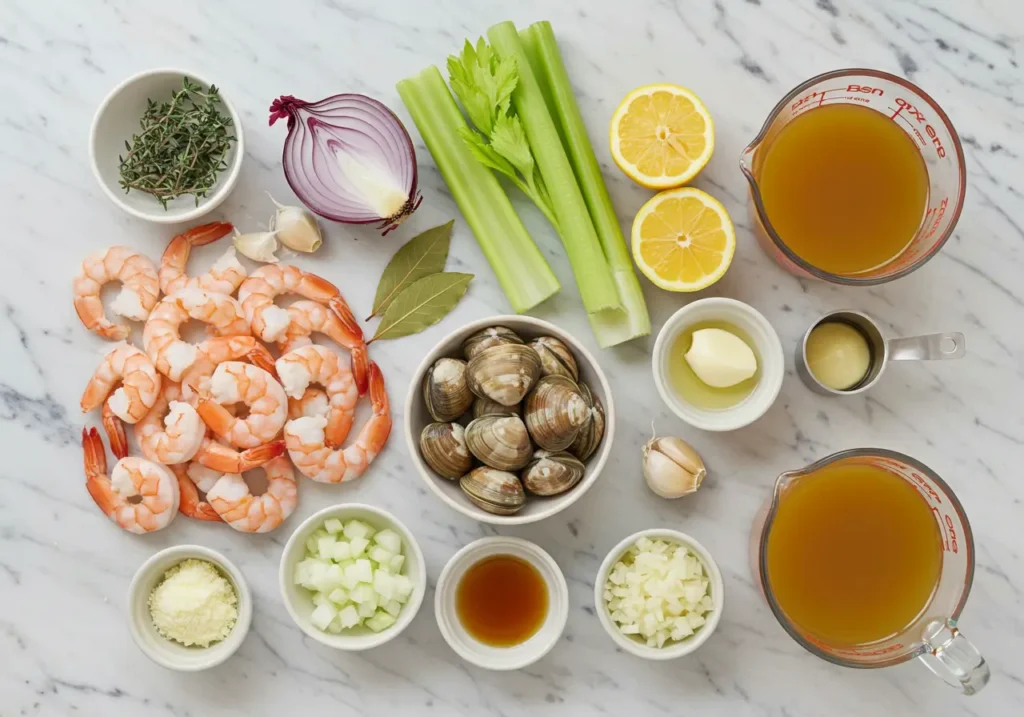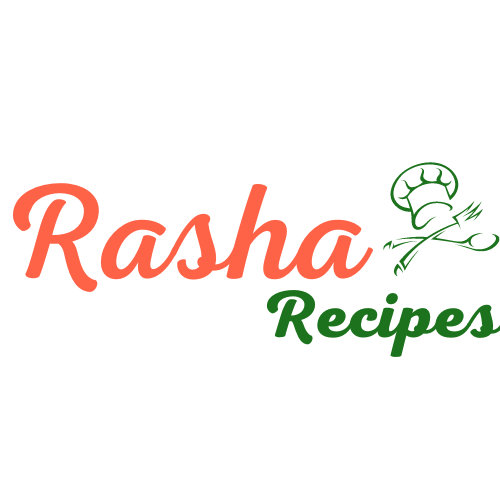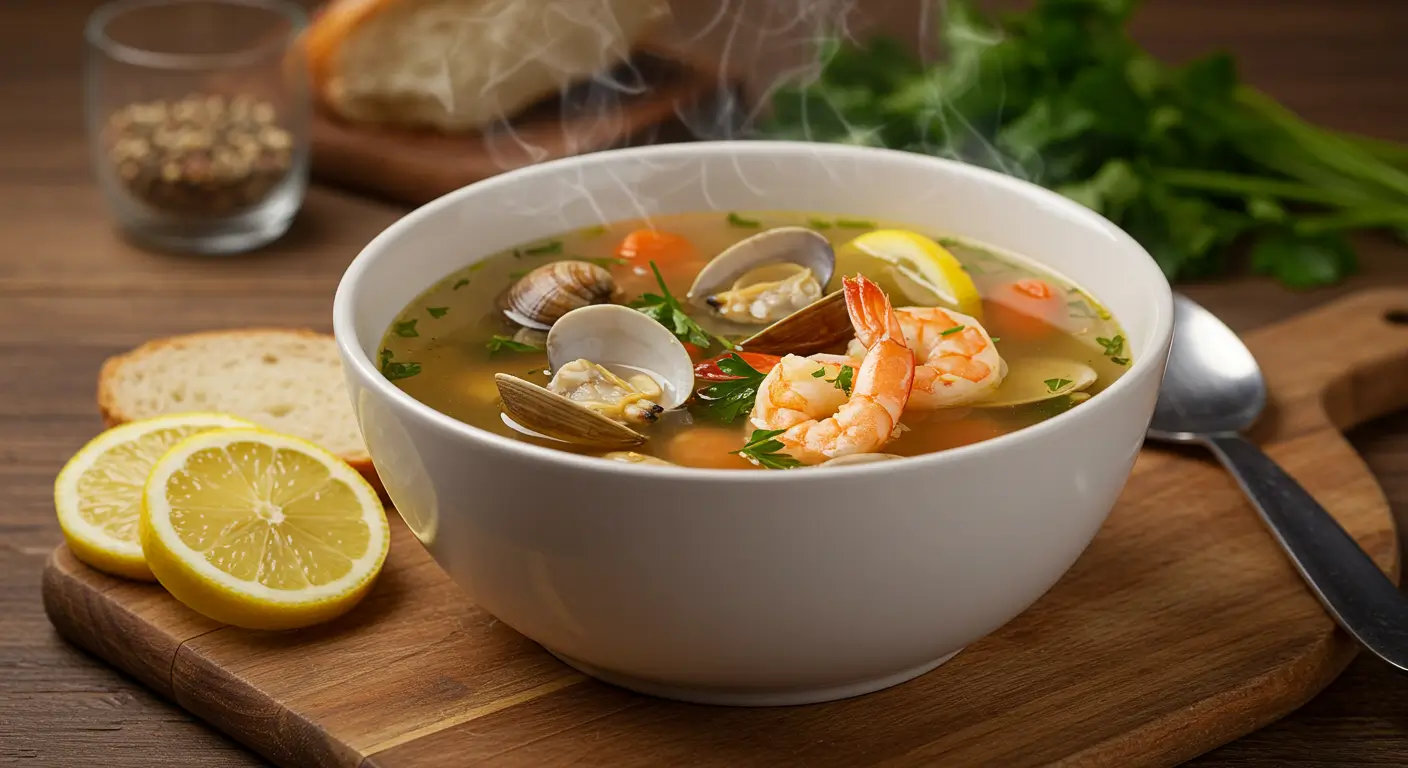Ever just wanna throw something comforting together that doesn’t take forever? This clam shrimp broth recipe is that dish. It’s quick, hearty, and brimming with seafood flavor—perfect for when you need something cozy but still wanna feel kinda fancy. If you love meals that hit that sweet spot between easy and impressive, you’re gonna wanna save this one.
Whether you’re a seafood lover or just curious about new flavors, this simple broth brings comfort and sophistication into your kitchen without the drama. It’s a weekday winner, a last-minute lifesaver, and a nourishing go-to when you’re in the mood for something that tastes like it took all day, without actually doing that.
Table of Contents
Why You’ll Love This Clam Shrimp Broth Recipe

Preparing a comforting, restaurant-quality seafood dish doesn’t have to take hours or require rare ingredients. With this quick clam shrimp broth, you can enjoy bold flavor and satisfying texture in less than 30 minutes — no fancy techniques or hard-to-find items needed. Whether your schedule feels packed or you’re simply craving something warm and nourishing, this recipe delivers exactly that with minimal effort and maximum taste.
It’s ready in under 30 minutes for busy weeknights
Time is one of the most valuable resources we have, especially on busy evenings when cooking feels like just another task on the list. That’s why this clam shrimp broth recipe was designed to be fast without sacrificing quality. From start to finish, you’ll spend less than half an hour pulling together a rich, aromatic dish that feels like it simmered all day. The process is straightforward: sauté, simmer, and serve. No hours of waiting or constant stirring required. Just real food made quickly, so you can get back to what matters most.
Packed with fresh seafood flavor without complicated steps
You don’t need a culinary degree to make something delicious. This clam shrimp broth recipe proves that simplicity can still deliver deep, savory flavor. The natural sweetness of shrimp and clams shines through, enhanced by garlic, onion, herbs, and a splash of lemon juice for brightness. There’s no mystery here — just wholesome ingredients working together to create a satisfying bowl of comfort. Even if you’re not confident in the kitchen, this recipe walks you through each step clearly, so you can feel good about what you’re serving.
Perfect for family dinners or meal prep
This clam shrimp broth recipe works beautifully as a weeknight dinner centerpiece or as part of your meal prep routine. Serve it alongside rice, crusty bread, or noodles, and you’ve got a well-rounded, flavorful meal that everyone at the table will enjoy. Since it stores well in the fridge and freezes beautifully, you can make a large batch and portion it out for quick lunches or dinners throughout the week. It’s a smart way to save time while still eating well — and who doesn’t want more of that?
Versatile base you can customize with your favorite ingredients
One of the best things about this broth is how adaptable it is. Think of it as a canvas for your creativity. Add diced tomatoes for richness, spinach or kale for extra greens, or coconut milk for a creamy, slightly sweet twist. Want to switch up the protein? Try adding scallops, mussels, or even chunks of firm white fish. The base recipe sets you up for success, but the variations are endless. Tailor it to suit your tastes, dietary needs, or whatever you have on hand in the pantry and fridge.
Whether you’re new to cooking seafood or looking for a reliable, go-to dish, this quick clam shrimp broth recipe hits every note: speed, flavor, versatility, and ease. And best of all, making it a great fit for a variety of eating styles and preferences. Read on to find out exactly what you’ll need to make it happen.
What You’ll Need to Make This Clam Shrimp Broth Recipe

Creating a rich, satisfying clam shrimp broth recipe doesn’t require rare or hard-to-find ingredients. The secret lies in choosing quality items that layer flavor naturally, without relying on alcohol or pork-based products. This version is clean, fresh, and built with convenience in mind — perfect for weeknights or meal prep. Below is everything you need to make this quick seafood broth in under 30 minutes, along with helpful notes on alternatives and where to find the best ingredients.
Full Ingredient List
This Clam Shrimp Broth Recipe uses simple components that come together for a deeply savory, aromatic dish. Here’s what you’ll need:
Clams (1 pound): Littleneck or cherrystone clams are ideal for their tender texture and briny sweetness. If using fresh, look for ones that are tightly closed or close when tapped — these are alive and safe to cook. Canned clams work well too; just drain and rinse them before adding to the pot.
Shrimp (½ pound, medium size, peeled and deveined): Choose either raw frozen shrimp (thawed before use) or fresh shrimp that feels firm and smells clean. Peeled and deveined varieties cut down on prep time, making this recipe even faster.
Fresh Aromatics (onion, garlic, celery): A diced yellow onion brings mild sweetness, smashed garlic adds boldness, and finely chopped celery contributes a light herbal note. These three form the base of flavor in the broth.
Fresh Herbs (parsley, thyme, bay leaf): Parsley adds a fresh pop of brightness that lifts the entire broth, while thyme or even a lone bay leaf brings cozy, earthy undertones that round out the flavor. If you’ve got fresh herbs, go for it—they shine here. But if you’re working with dried thyme, no stress—remember to cut the amount in half since it’s more concentrated.
Broth (4 cups): Low-sodium vegetable broth is ideal for a lighter taste, while seafood stock enhances the oceanic richness. If you want to keep it very simple, water works fine — the seafood juices will still bring natural flavor.
Lemon Juice (2 tablespoons, freshly squeezed): Adds acidity and freshness, replacing the role wine would usually play in seafood dishes. Fresh lemon makes a noticeable difference here.
Salt and Black Pepper (to taste): Adjust seasoning at the end, as clams naturally add some saltiness.
Oil (1 tablespoon olive or avocado oil): Used to sauté the aromatics. Stick with neutral oils that don’t overpower the seafood flavors.
These ingredients combine to create a balanced, full-bodied broth — all within 30 minutes and with no alcohol or pork involved.
Dietary-Friendly Substitutions
This recipe is naturally flexible and easy to adjust for various dietary needs. Here’s how to make it work for different preferences:
Gluten-Free: This dish is gluten-free by default, as long as your broth doesn’t contain wheat additives. Always check labels for allergens.
Low-Sodium: Skip added salt completely and let the seafood and herbs do the flavor work. Use water instead of store-bought broth for better sodium control.
Dairy-Free: The recipe already avoids dairy, so no changes are needed. Stick with olive oil or another plant-based oil.
Vegan Option: To enjoy a plant-based version, replace the seafood entirely with mushrooms like shiitake or oyster mushrooms. For extra umami and a hint of the sea, add a splash of soy sauce or kelp powder.
Keto or Low-Carb Friendly: Naturally low in carbs, this broth becomes keto-approved by avoiding starchy additions like potatoes or flour-thickened broths.
With these options, this broth can easily become a go-to dish for many eating styles.
Tips for Sourcing Quality Seafood
The flavor of your broth depends heavily on the quality of the seafood you choose. Here are some practical suggestions for finding the best ingredients:
Local Fish Markets (if you live near the coast): Visit local seafood counters or docks where fishermen sell directly. Look for clams stored on ice and shrimp that appear firm and glossy. Ask about the catch date or delivery schedule for the freshest picks.
Supermarkets: Most grocery stores carry fresh clams in the seafood case. Good signs include tightly shut shells and a clean, ocean-like smell. For shrimp, frozen bags of pre-cleaned shrimp are often more consistent and budget-friendly than fresh.
Frozen Seafood: Don’t overlook frozen options — they’re often flash-frozen right after harvest, preserving flavor and texture. Choose individually quick-frozen (IQF) shrimp and vacuum-packed clams for the best results. Thaw in cold water or overnight in the fridge.
Online Seafood Delivery: Services like Vital Choice, Wild Alaskan Company, and others offer high-quality, sustainably sourced shellfish delivered straight to your home. Great for people who lack nearby fish markets.
With your ingredients ready and your pantry stocked, you’re set to begin cooking. In the next section, we’ll walk through each step of making this fast, flavorful clam shrimp broth — no special tools or techniques required.
Step-by-Step Guide to Cooking Clam Shrimp Broth Recipe
Making a rich, satisfying clam shrimp broth recipe is simpler than it may seem. With just a few easy steps and the right timing, you can create a deeply flavorful dish in under 30 minutes — no advanced cooking skills required. The key lies in building layers of flavor, starting with aromatics and ending with fresh herbs and citrus. Just follow these clear, step-by-step instructions for a perfect seafood broth every time.
Step 1: Sauté the Aromatics – Onions, Garlic, and Herbs
Begin by heating one tablespoon of olive oil or avocado oil in a large pot over medium heat. Add the diced yellow onion and cook gently for about 3–4 minutes, stirring occasionally, until it starts to soften and turn translucent.
Next, add the smashed garlic cloves and stir for another minute or so, just until fragrant but not browned. Garlic burns easily, so keep an eye on it during this stage.
Now, stir in your choice of fresh herbs — a bay leaf and a few sprigs of thyme work beautifully here. If using fresh parsley stems (which add great depth), toss them in at this point too. Let everything simmer together for another minute to release their essential oils and build that foundational layer of flavor.
This base sets the tone for the entire dish, giving your broth a savory, aromatic backbone without any heaviness.
Step 2: Deglaze the Pot with Liquid to Build Flavor
Once the aromatics are cooked down, it’s time to deglaze the pot and lift all those golden bits stuck to the bottom — they’re full of concentrated flavor.
Pour in about half a cup of your liquid — either vegetable broth or seafood stock works well. You can also use water if you prefer a lighter taste. Stir well, scraping the bottom of the pot as it simmers for about 1–2 minutes.
This small but crucial step ensures none of the flavor goes to waste and gives your broth a deeper, more complex taste without needing wine or alcohol.
Then, add the remaining broth — bringing the total to about 4 cups. Raise the heat slightly and let it come to a gentle boil before reducing to a steady simmer.
Step 3: Simmer the Broth with Shrimp and Clams Until Tender
Once the broth is gently bubbling, add the clams first. If using fresh clams in shells, cover the pot and let them steam for about 5–7 minutes, or until the shells open — discard any that remain closed after cooking.
If using canned clams, wait until the last few minutes to add them, so they don’t become rubbery. Stir them in once the broth has reduced slightly and developed more body.
Now, add the shrimp. Since they cook quickly, only simmer them for 3–4 minutes, or until they turn pink and opaque. Be careful not to overcook them — they should feel firm but still tender when bitten into.
At this point, the broth will be richly scented with seafood, herbs, and just a touch of sweetness from the vegetables. It should have a clean, balanced flavor — not overly salty or fishy.
Step 4: Finish with Fresh Lemon and Herbs
To brighten up the broth and give it a final punch of flavor, stir in two tablespoons of freshly squeezed lemon juice. This step adds a refreshing contrast to the richness of the seafood and herbs.
Taste the broth and adjust the seasoning with salt and black pepper as needed. Remember, the clams naturally add some salinity, so go light on the salt unless it feels flat.
Finally, remove the bay leaf and any herb stems you used earlier. Garnish generously with chopped fresh parsley for color and a final burst of freshness.
Your quick clam shrimp broth is now ready to serve. Ladle it into bowls and enjoy it as is, or pair it with crusty bread, rice, or noodles for a complete meal.
With this simple yet effective method, you’ve created a comforting, restaurant-quality broth in less than half an hour — and entirely without wine or pork. In the next section, we’ll explore how to serve and store your seafood broth for maximum enjoyment later.
Best Tools for Making Clam Shrimp Broth Recipe
Serving & Storing Your Clam Shrimp Broth Recipe

Once your quick clam shrimp broth recipe is ready, it’s time to enjoy it. This dish shines on its own with a simple garnish of lemon and herbs, but pairing it thoughtfully can elevate it into a more complete and satisfying meal. Whether you’re enjoying it right away or planning ahead, this section will guide you through the best ways to serve and store your seafood broth — without compromising flavor or texture.
Best Ways to Serve: With Bread, Rice, or Pasta
This broth is rich in flavor and light enough to enjoy solo, but serving it alongside other ingredients enhances both comfort and satisfaction. Here are a few easy ideas that pair beautifully:
- Crusty bread: A warm slice of baguette or sourdough works perfectly for soaking up every last drop of broth. Toasting the bread adds a nice crunch and prevents it from getting soggy too quickly.
- Rice: For a heartier meal, ladle the broth over a bed of steamed white rice or brown rice. The grains absorb the savory liquid, making each bite flavorful. Jasmine or basmati rice also add a subtle floral note that complements seafood well.
- Pasta: Toss the broth with buttery egg noodles or spaghetti for an Italian-inspired twist. Or stir it into cooked farfalle (bowtie pasta) with a handful of spinach for a comforting weeknight dinner.
- Greens: Add a boost of nutrition by stirring in baby spinach, kale, or Swiss chard during the last few minutes of cooking. The greens wilt gently and bring color and fiber to the dish.
These serving suggestions make it easy to stretch the meal further while keeping things flexible based on what you have on hand.
How to Store Leftovers Safely in the Fridge or Freezer
Seafood dishes can be tricky to store, but with proper handling, this broth keeps well and tastes great even the next day. Here’s how to store it correctly:
- In the fridge: Let the broth cool completely before transferring it to an airtight container. Keep it refrigerated for up to 3 days. Make sure the seafood is fully submerged in liquid to help preserve freshness and texture.
- In the freezer: If you want to save some for later, freeze the broth in portion-sized containers or heavy-duty zip-top bags. Label them clearly and store for up to 2 months. For best results, remove the shrimp and clams before freezing and add fresh ones when reheating.
- Storage tips: Avoid storing the broth in metal pots for long periods, as seafood can develop a metallic taste. Glass or BPA-free plastic containers work best.
Proper storage ensures your broth stays safe and delicious, so you can enjoy it again without waste.
Reheating Tips to Keep Seafood Tender
Reheating seafood properly is key to maintaining its delicate texture. Since shrimp and clams are sensitive to heat, avoid using high temperatures or long cooking times. Here’s how to reheat without overcooking:
- Stovetop method (best option): Gently rewarm the broth in a saucepan over low heat. Stir occasionally and watch closely — once it’s hot, remove it from the burner immediately. If freezing earlier, add fresh shrimp and clams at this stage and simmer just until cooked through.
- Microwave method (for single servings): Use a microwave-safe bowl and cover it loosely with a lid or paper towel. Heat in short intervals (30 seconds to 1 minute), stirring between each round, until warmed through.
- Avoid boiling: Reheating too aggressively makes shrimp rubbery and clams tough. Always opt for slow, gentle warming.
With these tips, your leftover broth can taste nearly as good as when it was first made.
Meal Prep Ideas Using Seafood Broth as a Base
If you’re planning meals ahead, this easy-to-make broth is a great foundation to batch cook and build upon later. Here are a few smart ways to use it in your weekly routine:
- Prepped portions: Make a large batch and divide it into individual containers. Freeze some and refrigerate others for lunch or dinner throughout the week.
- Quick seafood bowls: Combine broth with pre-cooked rice or quinoa, roasted vegetables, and a protein like grilled chicken or tofu for a balanced bowl-style meal.
- Customizable dinners: Keep the base broth separate from toppings like cooked shrimp, steamed clams, or chopped herbs. Assemble meals when ready to eat for maximum freshness.
- Soups and stews: Use the broth as a starting point for other seafood-based soups. Add coconut milk for a creamy twist, or diced tomatoes for extra richness.
Because this broth is versatile and freezer-friendly, it’s perfect for building variety into your meal plans without spending more time in the kitchen.
With the right serving and storage strategies, your quick clam shrimp broth recipe becomes more than just a one-time meal — it’s a go-to ingredient for nourishing, fast dinners all week long. In the final section, we’ll answer common questions about preparing and customizing seafood broths, so you can feel confident experimenting with the recipe.
Learn The Best Taco Soup Fritos Recipe in our full guide.
Frequently Asked Questions
Can I use other seafood like mussels or scallops?
Yes, you can absolutely substitute or add different types of seafood to this broth. Mussels are an excellent alternative to clams — they open quickly and bring the same briny depth. Just be sure to clean them well before cooking and discard any that remain closed after simmering.
Scallops also work well but should be added toward the end of cooking to avoid overcooking. If using sea scallops, slice them into thinner rounds for even texture. Firm white fish like hake or cod can be dropped in chunks near the end of the broth’s cook time as well.
The key is to match each type of seafood to its ideal cooking time so nothing ends up rubbery or undercooked.
Is this recipe keto or gluten-free friendly?
Yes, this clam shrimp broth is naturally both keto-friendly and gluten-free, provided you follow a few simple guidelines.
Since there are no grains or starchy ingredients in the base recipe, it fits perfectly into a low-carb or ketogenic meal plan. To keep it keto, avoid adding potatoes, corn, or flour-thickened sauces.
For a gluten-free version, double-check that your broth or stock doesn’t contain wheat-based additives — most vegetable or seafood broths are safe, but always read labels carefully. The rest of the ingredients are naturally free from gluten, including herbs, lemon juice, and all types of fresh seafood.
If you’re serving with bread or pasta, choose grain-free or certified gluten-free options to maintain dietary compliance.
How do I avoid overcooked shrimp or rubbery clams?
Overcooked seafood can ruin an otherwise great dish, but with a little attention, you can keep your shrimp tender and your clams soft.
Shrimp only take about 3–4 minutes to cook once added to the hot broth. Look for them to turn pink and opaque — if they curl tightly or feel hard to the bite, they’ve likely been cooked too long.
Clams in shells open when done, usually within 5–7 minutes of simmering. Remove them from heat as soon as they open. Any clams that stay shut should be discarded. Canned clams require minimal cooking — just warm them through at the end to preserve their texture.
Paying close attention to timing ensures your seafood stays delicate and flavorful.
What if I don’t have wine — what can I substitute?
This recipe was created without wine from the start, so you won’t miss out on flavor by skipping it entirely. However, if you’re used to using wine in seafood dishes and want a similar effect, here are some great non-alcoholic alternatives:
- Fresh lemon juice: Brightens the broth and balances richness. Use about 1–2 tablespoons depending on taste.
- Apple cider vinegar: Adds acidity and depth. A small splash (½–1 tablespoon) works best.
- Tomato paste: Deepens the flavor profile. Stir in 1 teaspoon during the sauté stage for a richer broth.
- Miso paste (white or light): Offers umami and complexity. Add 1 teaspoon at the end and stir well.
- Coconut milk: For a creamy, subtly sweet twist, especially in Thai or Southeast Asian-inspired versions.


1 thought on “Easy Clam Shrimp Broth Recipe Under 30 Minutes”